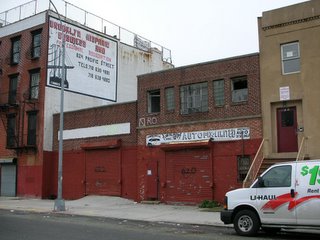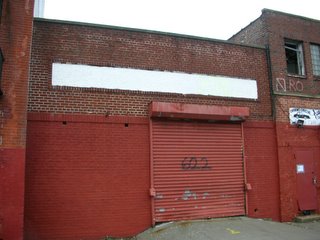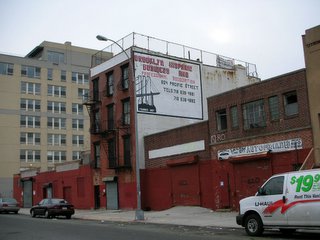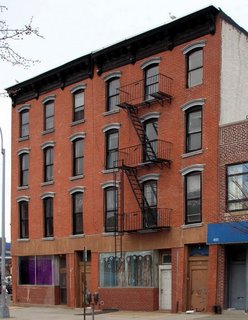Friday, January 20, 2006
Some "blight" back story: replacement was planned for building that Ratner wants to raze
Now that the demolition controversy is back in the news, some back story: the smallest of the six buildings Forest City Ratner plans to raze--a one-story garage at 622 Pacific Street (small building at left, below)--had been purchased by an investor who planned a five-story building there. That's before the investor, Menachem Friedfertig, publicly asked the developer for $4 million, according to a 9/2/04 New York Sun report. Did he get it? Unclear--but he likely got far more what he paid: $382,000 on 5/20/03, which was two months before the Atlantic Yards plan was mentioned by the Newark Star-Ledger 7/23/03 and nearly seven months before it was announced officially on 12/10/03.
The building is among those Forest City Ratner either owns or has under contract, according to a company press release, though available documents, at PropertyShark.com, do not indicate that the ownership has changed. But the transaction adds another layer to the issue of blight and its role in a future eminent domain case. Is the area blighted because it has deteriorating buildings? Is a deteriorated building less an indication of blight if the market was already responding? Or will it make little difference, since as a law professor has noted, current state law on blight is extremely loose?
But the transaction adds another layer to the issue of blight and its role in a future eminent domain case. Is the area blighted because it has deteriorating buildings? Is a deteriorated building less an indication of blight if the market was already responding? Or will it make little difference, since as a law professor has noted, current state law on blight is extremely loose?
At 622 Pacific Street, the 25 ft x 68 ft building sits on a lot 25 ft x 73.75 ft. Under current city zoning rules, it could support a Floor Area Ratio of 4, or a maximum of 5,382 square feet. That would suggest a five-story building, much smaller than the arena+high-rises slated to be built at that part of the site. Note that, because Atlantic Yards is a state project, city zoning rules don't apply.
Note that, because Atlantic Yards is a state project, city zoning rules don't apply.
According to the New York Sun, whose 9/2/04 article was headlined Message to Ratner: ‘I Want My $4M’: Brooklyn Developer Looks To Cash In, an effort to develop the site likely added leverage:
Friedfertig pushed ahead with a plan to develop the building, with medical offices on the first floor and five stories of residential condominiums above. He even went so far as to hire architects and get permission from the city’s Department of Buildings....
Despite the risk of eminent domain, Mr. Friedfertig’s threat to wring millions out of Mr. Ratner is formidable because he has the city’s approval to build his development....
“I am waiting for Ratner to make a realistic offer, or I could just go ahead with the development,” Mr. Friedfertig said.
Architects Joe and Moshe Friedman have drawn up plans for Mr. Friedfertig’s building, and the developer expects that each condominium could be sold for about $1 million — the same price Mr. Ratner has paid for other apartments that have stood in the way of the Atlantic Yards development. An additional $1 million to $2 million could be generated by the medical offices, bringing the total for the developed building to $6 million to $7 million, Mr. Friedfertig said.
Friedfertig had the plans drawn up in early 2004, which suggests he could also have been using the condominium project as a bargaining chip. He clearly felt he had lucked out, telling the Sun, "I have the winning lottery ticket and I want my $4 million." Forest City Ratner has not been a chintzy spender. An 11/6/05 New York Times article reported that, one factor that has contributed to the higher projected cost of Atlantic Yards, from $2.5 billion to $3.5 billion, has been the above-market prices the developer has paid to buy out residents who live on the project's footprint. And the company has likely paid above-market prices to buy out other property owners. Such costs factor into Forest City Ratner's profit estimates, which remain unreleased by the MTA.
He clearly felt he had lucked out, telling the Sun, "I have the winning lottery ticket and I want my $4 million." Forest City Ratner has not been a chintzy spender. An 11/6/05 New York Times article reported that, one factor that has contributed to the higher projected cost of Atlantic Yards, from $2.5 billion to $3.5 billion, has been the above-market prices the developer has paid to buy out residents who live on the project's footprint. And the company has likely paid above-market prices to buy out other property owners. Such costs factor into Forest City Ratner's profit estimates, which remain unreleased by the MTA.
Developer's blight?
 Also, a look at city records suggests that charges of "developer's blight"--that the building deteriorated while under the control of Ratner--may be murky here, as there were several violations and complaints, including a partially collapsed roof cited in January 1998. Then again, it's not clear why the building now poses an immediate danger and must be demolished. By contrast, there are fewer complaints at the recently-inhabited row houses at 461 and 463 Dean Street, at right. There's one violation, from 1922, at 461 Dean Street, and three boiler violations, two dismissed and one active, at 463 Dean Street. That's not to say that complaints are a proxy for deterioration.
Also, a look at city records suggests that charges of "developer's blight"--that the building deteriorated while under the control of Ratner--may be murky here, as there were several violations and complaints, including a partially collapsed roof cited in January 1998. Then again, it's not clear why the building now poses an immediate danger and must be demolished. By contrast, there are fewer complaints at the recently-inhabited row houses at 461 and 463 Dean Street, at right. There's one violation, from 1922, at 461 Dean Street, and three boiler violations, two dismissed and one active, at 463 Dean Street. That's not to say that complaints are a proxy for deterioration.
Jay Butler, a professional engineer who conducted an external review of the buildings on behalf of community groups suing to stop the demolitions, acknowledged that he couldn't make definitive judgments without going inside, but stated: I cannot conclude that the buildings pose an imminent threat to public safety. Any defects to the buildings or threats to public safety appear to be consistent with conditions found at countless other buildings in New York City.
He did not comment on 622 Pacific Street because, despite statements in Forest City Ratner's initial press release, the report to the developer by LZA Technology did not mention the building. According to the lawsuit filed Wednesday, the lawyer for ESDC said that the agency's Emergency Declaration did not apply to 622 Pacific Street, but noted that the developer planned to submit another engineer’s report in support of demolition there.
The building is among those Forest City Ratner either owns or has under contract, according to a company press release, though available documents, at PropertyShark.com, do not indicate that the ownership has changed.
 But the transaction adds another layer to the issue of blight and its role in a future eminent domain case. Is the area blighted because it has deteriorating buildings? Is a deteriorated building less an indication of blight if the market was already responding? Or will it make little difference, since as a law professor has noted, current state law on blight is extremely loose?
But the transaction adds another layer to the issue of blight and its role in a future eminent domain case. Is the area blighted because it has deteriorating buildings? Is a deteriorated building less an indication of blight if the market was already responding? Or will it make little difference, since as a law professor has noted, current state law on blight is extremely loose?At 622 Pacific Street, the 25 ft x 68 ft building sits on a lot 25 ft x 73.75 ft. Under current city zoning rules, it could support a Floor Area Ratio of 4, or a maximum of 5,382 square feet. That would suggest a five-story building, much smaller than the arena+high-rises slated to be built at that part of the site.
 Note that, because Atlantic Yards is a state project, city zoning rules don't apply.
Note that, because Atlantic Yards is a state project, city zoning rules don't apply. According to the New York Sun, whose 9/2/04 article was headlined Message to Ratner: ‘I Want My $4M’: Brooklyn Developer Looks To Cash In, an effort to develop the site likely added leverage:
Friedfertig pushed ahead with a plan to develop the building, with medical offices on the first floor and five stories of residential condominiums above. He even went so far as to hire architects and get permission from the city’s Department of Buildings....
Despite the risk of eminent domain, Mr. Friedfertig’s threat to wring millions out of Mr. Ratner is formidable because he has the city’s approval to build his development....
“I am waiting for Ratner to make a realistic offer, or I could just go ahead with the development,” Mr. Friedfertig said.
Architects Joe and Moshe Friedman have drawn up plans for Mr. Friedfertig’s building, and the developer expects that each condominium could be sold for about $1 million — the same price Mr. Ratner has paid for other apartments that have stood in the way of the Atlantic Yards development. An additional $1 million to $2 million could be generated by the medical offices, bringing the total for the developed building to $6 million to $7 million, Mr. Friedfertig said.
Friedfertig had the plans drawn up in early 2004, which suggests he could also have been using the condominium project as a bargaining chip.
 He clearly felt he had lucked out, telling the Sun, "I have the winning lottery ticket and I want my $4 million." Forest City Ratner has not been a chintzy spender. An 11/6/05 New York Times article reported that, one factor that has contributed to the higher projected cost of Atlantic Yards, from $2.5 billion to $3.5 billion, has been the above-market prices the developer has paid to buy out residents who live on the project's footprint. And the company has likely paid above-market prices to buy out other property owners. Such costs factor into Forest City Ratner's profit estimates, which remain unreleased by the MTA.
He clearly felt he had lucked out, telling the Sun, "I have the winning lottery ticket and I want my $4 million." Forest City Ratner has not been a chintzy spender. An 11/6/05 New York Times article reported that, one factor that has contributed to the higher projected cost of Atlantic Yards, from $2.5 billion to $3.5 billion, has been the above-market prices the developer has paid to buy out residents who live on the project's footprint. And the company has likely paid above-market prices to buy out other property owners. Such costs factor into Forest City Ratner's profit estimates, which remain unreleased by the MTA.Developer's blight?
 Also, a look at city records suggests that charges of "developer's blight"--that the building deteriorated while under the control of Ratner--may be murky here, as there were several violations and complaints, including a partially collapsed roof cited in January 1998. Then again, it's not clear why the building now poses an immediate danger and must be demolished. By contrast, there are fewer complaints at the recently-inhabited row houses at 461 and 463 Dean Street, at right. There's one violation, from 1922, at 461 Dean Street, and three boiler violations, two dismissed and one active, at 463 Dean Street. That's not to say that complaints are a proxy for deterioration.
Also, a look at city records suggests that charges of "developer's blight"--that the building deteriorated while under the control of Ratner--may be murky here, as there were several violations and complaints, including a partially collapsed roof cited in January 1998. Then again, it's not clear why the building now poses an immediate danger and must be demolished. By contrast, there are fewer complaints at the recently-inhabited row houses at 461 and 463 Dean Street, at right. There's one violation, from 1922, at 461 Dean Street, and three boiler violations, two dismissed and one active, at 463 Dean Street. That's not to say that complaints are a proxy for deterioration.Jay Butler, a professional engineer who conducted an external review of the buildings on behalf of community groups suing to stop the demolitions, acknowledged that he couldn't make definitive judgments without going inside, but stated: I cannot conclude that the buildings pose an imminent threat to public safety. Any defects to the buildings or threats to public safety appear to be consistent with conditions found at countless other buildings in New York City.
He did not comment on 622 Pacific Street because, despite statements in Forest City Ratner's initial press release, the report to the developer by LZA Technology did not mention the building. According to the lawsuit filed Wednesday, the lawyer for ESDC said that the agency's Emergency Declaration did not apply to 622 Pacific Street, but noted that the developer planned to submit another engineer’s report in support of demolition there.